#African training exercise
Text
youtube
#youtube#militarytraining#13th Obangame Express#maritime domain awareness#security cooperation#African partners#African training exercise#Africa#African security.#naval operations#naval forces#military training#multinational exercise#maritime safety#Atlantic Ocean#naval training#maritime security#United States Navy#military drill#military exercise#U.S. Military#counter-piracy
1 note
·
View note
Note
can u elaborate on posture being a lie
As Beth Linker explains in her book “Slouch: Posture Panic in Modern America” (Princeton), a long history of anxiety about the proximity between human and bestial nature has played out in this area of social science. Linker, a historian of medicine at the University of Pennsylvania, argues that at the onset of the twentieth century the United States became gripped by what she characterizes as a poor-posture epidemic: a widespread social contagion of slumping that could, it was feared, have deleterious effects not just upon individual health but also upon the body politic. Sitting up straight would help remedy all kinds of failings, physical and moral [...] she sees the “past and present worries concerning posture as part of an enduring concern about so-called ‘diseases of civilization’ ”—grounded in a mythology of human ancestry that posits the hunter-gatherer as an ideal from which we have fallen.
[...]
In America at the turn of the twentieth century, anxieties about posture inevitably collided with anxieties not just about class but also about race. Stooping was associated with poverty and with manual, industrialized labor—the conditions of working-class immigrants from European countries who, in their physical debasement, were positioned well below the white Anglo-Saxon Protestant establishment. Linker argues that, in this environment, “posture served as a marker of social status similar to skin color.” At the same time, populations that had been colonized and enslaved were held up as posture paradigms for the élite to emulate: the American Posture League rewarded successful students with congratulatory pins that featured an image of an extremely upright Lenape man. The head-carrying customs associated with African women were also adopted as training exercises for white girls of privilege, although Linker notes that Bancroft and her peers recommended that young ladies learn to balance not baskets and basins, which signified functionality, but piles of flat, slippery books, markers of their own access to leisure and education. For Black Americans, posture was even more fraught: despite the admiration granted to the posture of African women bearing loads atop their heads, community leaders like Dr. Algernon Jackson, who helped establish the National Negro Health Movement, criticized those Black youth who “too often slump along, stoop-shouldered and walk with a careless, lazy sort of dragging gait.” If slouching among privileged white Americans could indicate an enviable carelessness, it was seen as proof of indolence when adopted by the disadvantaged.
This being America, posture panic was swiftly commercialized, with a range of products marketed to appeal to the eighty per cent of the population whose carriage had been deemed inadequate by posture surveys. The footwear industry drafted orthopedic surgeons to consult on the design of shoes that would lessen foot and back pain without the stigma of corrective footwear: one brand, Trupedic, advertised itself as “a real anatomical shoe without the freak-show look.” The indefatigable Jessie Bancroft trained her sights on children’s clothing, endorsing a company that created a “Right-Posture” jacket, whose trim cut across the upper shoulders gave its schoolboy wearer little choice but to throw his shoulders back like Jordan Baker. Bancroft’s American Posture League endorsed girdles and corsets for women; similar garments were also adopted by men, who, by the early nineteen-fifties, were purchasing abdominal “bracers” by the millions.
It was in this era that what eventually proved to be the most contentious form of posture policing reached its height, when students entering college were required to submit to mandatory posture examinations, including the taking of nude or semi-nude photographs. For decades, incoming students had been evaluated for conditions such as scoliosis by means of a medical exam, which came to incorporate photography to create a visual record. Linker writes that for many male students, particularly those who had military training, undressing for the camera was no biggie. For female students, it was often a more disquieting undertaking. Sylvia Plath, who endured it in 1950, drew upon the experience in “The Bell Jar,” whose protagonist, Esther Greenwood, discovers that undressing for her boyfriend is as uncomfortably exposing as “knowing . . . that a picture of you stark naked, both full view and side view, is going into the college gym files.” The practice of taking posture photographs was gradually abandoned by colleges, thanks in part to the rise of the women’s movement, which gave coeds a new language with which to express their discomfort. It might have been largely forgotten were it not for a 1995 article in the Times Magazine, which raised the alarming possibility that there still existed stashes of nude photographs of famous former students of the Ivy League and the Seven Sisters, such as George H. W. Bush, Bob Woodward, Meryl Streep, and Hillary Clinton. Many of the photographs in question were taken and held not by the institutions themselves but by the mid-century psychologist William Herbert Sheldon. Sheldon was best known for his later discredited theories of somatotypes, whereby he attributed personality characteristics to individuals based on whether their build was ectomorphic, endomorphic, or mesomorphic.
[...]
Today, the descendants of Jessie Bancroft are figures like Esther Gokhale, a Bay Area acupuncturist and the creator of the Gokhale Method, who teaches “primal posture” courses to tech executives and whose recommendations are consonant with other fitness trends, such as barefoot running and “paleo” eating, that romanticize an ancestral past as a remedy for the ills of the present. The compulsory mass surveillance that ended when universities ceased the practice of posture photography has been replaced by voluntary individual surveillance, with the likes of Rafi the giraffe and the Nekoze cat monitoring a user’s vulnerability to “tech neck,” a newly named complaint brought on by excessive use of the kind of devices profitably developed by those paleo-eating, barefoot-running, yoga-practicing executives. Meanwhile, Linker reports, paleoanthropologists quietly working in places other than TikTok have begun to revise the popular idea that our ancient ancestors did not get aches and pains in their backs. Analysis of fossilized spines has revealed degenerative changes suggesting that “the first upright hominids to roam the earth likely experienced back pain, or would have been predisposed to such a condition if they had lived long enough.” Slouching, far from being a disease of civilization, then, seems to be something we’ve been prone to for as long as we have stood on our own two feet.
846 notes
·
View notes
Photo

A manbo (also written as mambo) is a priestess (as opposed to a oungan, a male priest) in the Haitian Vodou religion. Haitian Vodou's conceptions of priesthood stem from the religious traditions of enslaved people from Dahomey, in what is today Benin. For instance, the term manbo derives from the Fon word nanbo ("mother of magic"). Like their West African counterparts, Haitian manbos are female leaders in Vodou temples who perform healing work and guide others during complex rituals.
This form of female leadership is prevalent in urban centers such as Port-au-Prince (the capital of Haiti). Typically, there is no hierarchy among manbos and oungans. These priestesses and priests serve as the heads of autonomous religious groups and exert their authority over the devotees or spiritual servants in their hounfo (temples).
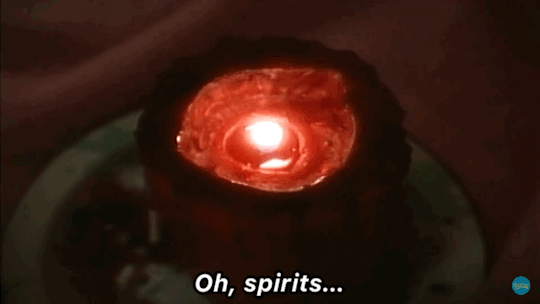
Manbos and oungans are called into power via spirit possession or the revelations in a dream. They become qualified after completing several initiation rituals and technical training exercises where they learn the Vodou spirits by their names, attributes, and symbols.
The first step in initiation is lave tèt (head washing), which is aimed at the spirits housed in an individual's head. The second step is known as kouche (to lie down), which is when the initiate enters a period of seclusion. Typically, the final step is the possession of the ason (sacred rattle), which enables the manbos or oungans to begin their work. One of the main goals of Vodou initiation ceremonies is to strengthen the manbo's konesans (knowledge), which determines priestly power.

The specific skills and knowledge gained by manbos enable them to mediate between the physical and spiritual realms. They use this information to call upon the spirits through song, dance, prayer, offerings, and/or the drawing of vèvès (spiritual symbols). During these rituals, manbos may either be possessed by a loa (also spelled lwa, Vodou spirits) themselves, or may oversee the possession of other devotees. Spirit possession plays an important role in Vodou because it establishes a connection between human beings and the Vodou deities or spirits. Although loas can "mount" whomever they choose, those outside the Vodou priesthood do not have the skills to communicate directly with the spirits or gods. This is because the human body is merely flesh, which the spirits can borrow to reveal themselves via possession. manbos, however, can speak to and hear from the Vodou spirits. As a result, they can interpret the advice or warnings sent by a spirit to specific individuals or communities.

Cécile Fatiman is a Haitian manbo famously known for sacrificing a black pig in the August 1791 Vodou ceremony at Bois Caïman—an act that is said to have ignited the Haitian Revolution. There are also notable manbos within the United States. Marie Laveau (1801-1888), for example, gained fame in New Orleans, Louisiana, for her personal charm and Louisiana Voodoo practices.
Renowned as Louisiana's "voodoo queen", Laveau's legacy is kept alive in American popular culture (e.g., the television series America Horror Story: Coven).ne Mama Lola is another prominent manbo and Vodou spiritual leader in the United States. She rose to fame after the publication of Karen McCarthy Brown's ethnographic account Mama Lola: A Vodou Priestess in Brooklyn. Mama Lola's success provided her with a platform to challenge Western misconceptions of Haitian Vodou and make television appearances

#kemetic dreams#vodun#cecile fatiman#manbo#bois caiman#manbos#haitian#marie laveau#new orleans#new orleans voodoo#mama lola#vodou#lwa#oungan#nando#fan#west african#west african vodun#mother of magic#joey bada$$#brooklyn
258 notes
·
View notes
Text
It Is Time For 'Baddie Hibernation'

Hey babes we have 3 months before the summer! It is time to tighten up! This is the time to work on your physical and mental I know we all want to be hot girls this summer so now is the time to prioritize ourselves!
Routines
♡ Routines are super important. they are your key to success and living an organized life. If you have not created a routine already I created a blog post on how to create a productive routine. This is the time to stick to your routines in the morning and night and adjust them if needed.
Physical
♡ Hygiene. Consistency is key for your facial care routine to work so be consistent in applying all your products. If you aren't seeing results with a certain product you have been using for over 3 months maybe try and find a better product. I recommend using a gua sha three times a week there are so many benefits in using a gua sha blog post coming soon! Don’t just focus on your facial care focus also on your body care use African exfoliating net sponges, shave regularly, apply lotions and body oils, and use feet masks to peel dead skin.
♡ Diet. For my girlies who are on a weight loss journey and want to be snatched before summer, it is time to be dedicated to sticking to your diet. I don’t have any specific diets to recommend do what works for you. If you struggle with Binge Eating Disorder like me I have a book that I can recommend that will help you work on your ED and also help you lose weight “The Binge Code” by Allison Kerr and Richard Kerr. This book has been a game-changer for me! For my babes who aren't focused on weight loss, it is still important to try and eat healthier try including a variety of whole foods into your diet and drink waterrr!!! Water is so good for us from our skin to our digestive system try and drink at least 50oz but aim for 100oz of water daily.
♡ Movement. Try and include some sort of movement daily we must move our bodies daily. Figure out what type of exercise you like walking is very simple and costs absolutely nothing. Start small with 10 minutes of outdoor walking daily. Natural light is so beneficial for our mental health and mood. Yoga and pilates are such amazing slow and impactful forms of exercise. I've been including yoga in my nighttime routine there are so many channels and videos on YouTube you can follow. There are so many other forms of exercise you can try some free and some that cost money.
♡ Supplements. Help and maintain our overall health they can also help with our daily requirements of essential nutrients. I will be listing a few supplements below <333
Multivitamin. Find a reputable multivitamin and take it daily or as instructed. Multivitamins can boost energy and give you vitamins and minerals you might be deficient in.
Magnesium. Improves mood, sleep, exercise performance, regulates blood sugar, and so much more. Magnesium is overlooked by many but so beneficial for us. I've been seeing the bedtime magnesium mocktail I have yet to try but I plan to.
Omega 3(fish oil). Helps with typical brain and eye development. It can fight inflammation and help prevent heart disease and the decline of brain function.
Vitamin D. A lot of us during the winter time have a deficiency in vitamin D because the sun is not out a lot so vitamin D supplements are a must-have they help with regulating mood, reducing depression, healthy bones, and so many other amazing benefits.
Vitamin B Complex. Helps boost energy levels, brain function, digestion, and cell health. There are so many other benefits.
Probiotics. Helps improve gut health, puts healthy bacteria into our gut that in turn helps our digestive system, and inflammation, and can even help aide your weightless journey.
Mental
♡ Sleep. Our bodies function so much better when we are getting a good amount of sleep. You think clearly and your mood is better. Try and set a bedtime for yourself and stick to it. I had to sleep train myself at the beginning of the semester it was so harddd but I'm reaping the benefits now I have energy during the day, my mood is better in the morning, and my brain functions better during the day.
♡ Journaling. We have a lot of emotions that we carry throughout the day and it is important that we let them out and journaling is the best way to do so. I have three journals. One journal is for my emotions, another for gratitude journaling which I highly recommend you get into, and finally my last journal for shadow work. You do not need to have three journals but I like to have everything separate it helps me.
♡ Book. I love reading and listening to self-help books. We all have issues that we need to fix and thankfully we have so many self-help books dedicated to so many different issues people face on a daily. I have so many recommendations I’ll list below.
The Mountain Is You by Brianna Wiest (self-sabotaging)
The Most Powerful Woman In The Room Is You by Lydia Fenet (confidence and career)
Atomic Habits by James Clear (building good habits)
The Subtle Art of Not Giving a F*ck by Mark Manson (living a carefree life)
The Binge Code by Allison Kerr and Richard Kerr (binge eating, weight loss)
The Shadow Work Journal by Keila Shaheen (internal healing)
The Eldest Daughter Effect by Lisette Schuitemaker and Wies Enthoven (eldest daughters)
The Game Of Life And How To Play It by Florence Scovel and Joel Fotinos (from pessimistic to optimistic, affirmations, and manifestation)
The Power Of The Pussy by Kara King (femininity and dating)
8 Rules Of Love by Jay Shetty (dating and psychology)
The Muslim Woman’s Manifesto by Kashmir Maryam (religion, mental health, and women)
These are the books I can recommend so far there are more searches for books related to the issues you may be facing or things you want to improve on in your life<3
♡ Therapy. I'm a big mental health advocate and it is very important that if you are dealing with mental health issues you get help<3. I've dealt with my issues before and I used better help I found the best therapist who helped me through so much. I love the way they allow you to choose your therapist. I recommend that you use better help. For my NYC teenagers between the ages of 13-17, there is a website called talk space that offers free online therapy for NYC teens NO REFERRAL IS NEEDED. If I find more websites that offer free therapy for other teens around the world I will let you all know<3.
If you have any tips that you want to share down in the comments please do I want all of us to be happy and glowing this summer!
#it girl#becoming that girl#clean girl#becoming her#glow up#it girl energy#dream girl#self love#self care#that girl#girlblogging#dream life#productivity#pink pilates girl#self improvement#green juice girl#soft productivity#productivitytips#consistency#self growth#routines#healthyhabits#wellness#positivity#girljournal#hyper feminine#motivation#my diary#pink blog#masterlist
41 notes
·
View notes
Text

HYBRID AU PART 2
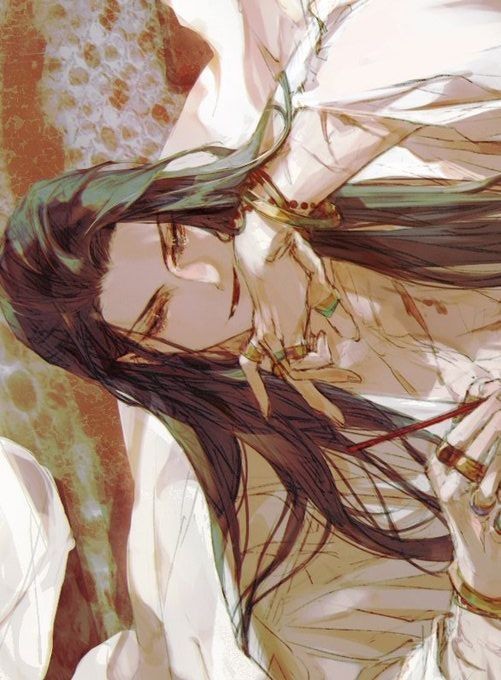
MARRAV
Marrav/Other members of the Vermillion ducal family
In this au they are not the imperial family, but are members of the Vermillion grand duchy which has two branches.
Valero is branch is for the members of Duke Nicolas family and Valryon is for the members of Marrav's family m
They are lions. African lions to be exact. To be even more detailed their super Lions ( super Lions are a small group of lions that are stronger and more mean and buff than the average lion.
Marrav is tall. Standing at 6'11. Has a muscular somewhat lean body. He's naturally athletic and doesn't need to do a lot to exercise because of his good genes.
His formerly sharp silver eyes now have an even more piercing look in them making both prey and predator hybrids alike freeze in their spots whenever they lock eyes with him.
Instead of his hair being all silky and flowy it somehow puffs a bit behind him like a lions mane, but it's still well taken care off. A pair of lion ears twitch every once in a while on his head and his long tail sways boredly behind him.
Dominant alpha
Always has a haughty smirk on his thin lip so can always see his sharp canines peaking out.
He's fucking Hot and he knows it.
He's got it all. The money, the looks, the genes, the power.
He's known through out the academy as the ' Black beast '.
He got this nickname mostly because of his thick black hair, but his monsterous gives the name another meaning.
Like Leon he is a member of the student council, but he focuses more on the training regiment of students who want to dedicate their time to swordsman ship. ( He mostly recruits predator hybrids because he's fucking bias and thinks all prey species are weak ).
He doesn't know like restraining his strength when sparing with others far weaker than him. Has broken limbs/ badly injured others because of this.
Instead of people being wary of him because of this, their like
" ✨UWU ✨ Big murder kitty is so hot💕 "
These insane people are members of his fanclub.
Oh yes.
He has a fanclub.
They call themselves ' the black kitty brigade '
He's embarrassed by them, but their praises always inflate his ego.
Every single student knows that he's trying to court Leon, including the freshmen.
His fans are torn between trying to get his attention or push him together with the blue haired lop bunny hybrid.
Members of his fan club are the main cause of M/N's torment. Their angry and disgusted that the sheep hybrid has the honour of being their murder kitty's future mate.
He's constantly butting heads with the other love intrests and his cousin.
An absolute prick. He's more of a hassle to handle than his Emperor self.
Also much more vocal about how he hates his engagement to M/N.
Sometimes does nice things for the sheep just so his fanclub have a reason to bully him, or he's the one verbally abusing/ berating him in the hallway in front of hundreds of other students.
An absolute jackass over all.

ALVAR.
His family is still a major part of the holy temple and still places a major role in choosing the Pope candidate, but in this Au his older sister is the pope while he goes to the academy to study.
He's a tiger.
A Bengal tiger. ( Bengal tigers are still tigers, they just have white fur, that's why I used them for Alvar because they match his aesthetic )
Another very pretty big kitty.
And unlike a certain someone he's a very gentle predator hybrid.
He's a just bit taller than Marrav standing at 6'12, also has a muscular lean form as well. Pretty silky waist length milky white hair paired with milk white cat like eyes top it all off with small fuzzy striped ears and a gentle swaying striped tale
Dominant alpha.
Like Marrav had the money, looks and power but is more humble about it.
Is known as the ' Gentle guardian ' by the students.
Predator and prey alike usually flock to him because of his comforting aura and how willing he is to help people in need.
Very smart and it almost always the top of his year.
The goody two shoes religious boi of the academy.
He's the head of the schools religious sector and is known for being knowledgeable on the words of the holy text. Is also the leader of the school choir.
Has a very pretty voice, it's deep so he sings bass.
His voice alone has gotten some very weak willed omegas off during mandatory service.
Is also a member of the student council.
His role later s mostly to act as a guidance counselor of sorts for students in need or struggling and help to put them on the right path.
Also has a fan club.
His fan club member are call themselves the ' Gentle snowflakes '.
They always knock heads with the black kitty brigade.
Like Marrav Alvar has a crush on a certain lop bunny and everyone knows.
His fan club members think he's the one who deserves the right to court the pretty omega since a gentle giant alpha would be perfect for a small prey omega.
They don't start fight because they don't want to soil the name of their giant soft kitty.
In this au since M/N doesn't have a 'demon' inside him Alvar actually gets along well with the sheep hybrid.
They both share similar tastes in books and he's the one M/N goes to to talk about how the bullying is taking a toll on him.
Sadly because of this relationship his own fanclub also have it out for the sheep and have tagged him as a ' ship wrecker '
Because he's so busy with a lot of things Alvar doesn't really have time to constantly check on the h/c fluffy omega make sure he's doing alright.
Overall a pretty meh person.

BASIL
In this au he's not necessarily found starving by M/N on the streets, but his family is a poor barony who's indebted to M/N's family. Since he's an illegitimate child born from a prostitute his father took him in so they could send him off a servant as a way to pay of their debt. Despite this M/N still treated him like an equal instead of a servant and even managed to convince his parents to sponsor Basil's education in the academy.
Is more like a butler that's trained very well on self defense and is skilled with a sword.
Is a mixed breed.
His father is a red fox while his mother was a local dog breed that he isn't aware of.
He got more of the fox genes so you can't tell he's mixed at all.
Has a lean body with a bit of muscle, stands at 6'0 pretty pink shoulder length hair that's tied in a ponytail. Pink furred fox ears and a soft fluffy fox tail that wags like a dog's tail when he's happy. Has a pretty face too.
Recessive alpha.
Isn't part of the school council, but is very popular among the student body.
Is considered a prodigy with the sword by students and teachers alike and has a lot of potential that can be unlocked.
He's received a lot of attention that his ego is almost as big as Marrav's.
Even though he's meant to be serving M/N he actively tries to avoid the sheep hybrid so his reputation doesn't get tarnished.
Even if the omega does manage to get a hold of him he likes to pretend he doesn't know him or give him the cold shoulder so it looks to others that he's annoyed by him.
Turns a blind eye to the bullying as well.
Doesn't have a fan club but the popularity he's gathered for himself make it look like he'll get one soon.
People know he's got a thing for Leon.
His normally lax tail starts wagging at the sight of the bunny.
People think it's cute that the normally stone faced fox becomes a cute kit at the sight of the pretty blue haired omega.
He's a shitty person that only cares about himself.
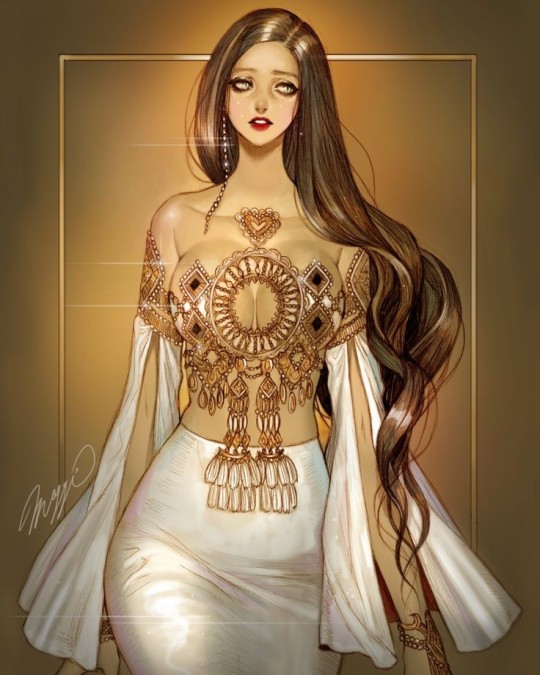
SHIVA
Mommy Shiva in the house! Nothing really changes other than she's not the empress, but one of her older siblings is rulling in her place.
Snake hybrid or for better words a Naga.
Like M/N who has more animal traits ( like the fluffy wool growing around his wrist to his hooved feet and fluffy wool legs ) Shiva is also like this with the lower part of her body being a snake tail decorated with gold and silver scales, these same scales are scattered on her arms , shouldersand the side of her face. Her already teal reptilian eyes have an even more animalistic shine behind them.
Drop dead handsome/ gorgeous.
If she's ' standing ' upright she's a little over 10 feet, but that draws attention towards her ( even though she likes how both students and teachers are intimidated by her ) so she tends to slouch a bit and let more of her tail slither around.
She's still 8'1 when she does this.
Long silky caramel hair, her face and body is an absolute work of art. Hot and she owns it.
People are in awe of her looks and also terrified of her beauty.
Dominant alpha.
Other than her height and intimidating looks another thing the student body fear about her is her venom.
Oh I forget to mention.
Shiva's breed of snake is the african boomslang.
Poisonous little fuckers.
Though she hides her fangs well and has never actually threatened anyone with it.
Well except Marrav, but she doesn't see him as a person anyways so that doesn't count.
She's not a student since she's older, but at the same time she doesn't really teach. She's part of the school board as a foreign education councillor representing Pentigria.
She watches over the students from her Empire to avoid any bad things toward her people.
Keeps to her self most of the time and is generally a mystery to the students.
Her and M/N relationship is one of mutual acquaintances.
They both find peace in each other's company and can be found talking together in the school cafe about trivial things.
She originally wanted to only get to know him just to spite Marrav but now she genuinely enjoys his company.
No one dares to speak ill of the sheep hybrid in her presence.
A student did once and nobody has seen them till now.
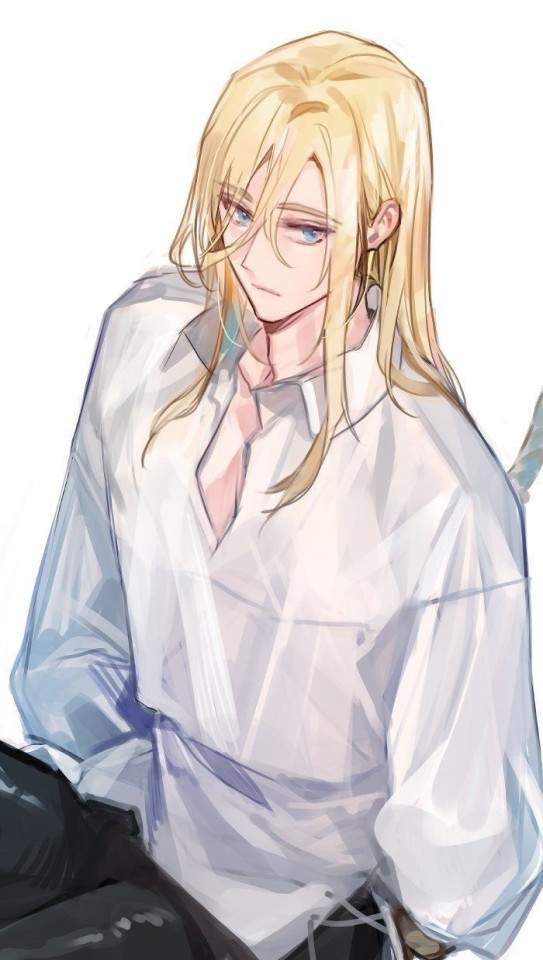
LOUIS
in this au he's still Alvar's illegitimate younger brother.
If you thought he had it bad in the original timeline well you thought wrong.
Cause it gets worse.
He's taken nothing from the Leoht family blood line. No milky white hair and eyes or earth dark skin.
Blond hair, green eyes and pale as a ghost.
As if that isn't enough he's not even a tiger hybrid.
I swear he's not even any thing in the cat species.
He's a horse.
A freaking horse.
He's breed of horse is a ' Thoroughbred '.
Recessive alpha.
One can only imagine the black lash and bullying he's experienced through out his life for this.
He's referred to as ' the curse '. People say that because they believe they believe the gods cursed him in the womb for being an illegitimate child , that's why he looks nothing like the rest of the family.
People originally thought his mother was playing tricks by saying that he even had Leoht blood.
Magic proved that she was in fact telling the truth.
Is treated like an outcast by his peers who constantly remind him that he's a mistake.
He can be found huddled on his own in one of the schools abandoned green house all by himself.
Unlike his og self care who hides behind a facade by being vain, rude and condescending, this Louis is actually really sweet and nice.
He and M/N are really close friends.
Hope you like this.
#x omega male reader#omegaverse#mc#dearly detested#ask#nobility#omega male reader#leon#anon#x male reader#hybrid au#Shiva#Basil#Marrav#Louis#Alvar#sheep mc
97 notes
·
View notes
Text

IMAGES: USAF B-1B Lancer bombers perform training with Swedish Air Force Gripens
Fernando Valduga By Fernando Valduga 02/29/2024 - 12:00 in Military
The U.S. Air Force B-1B Lancer bombers, assigned to the 28ª Bomber Wing of Ellsworth Air Base, North Dakota, took off from their deployment site at Lulea-Kallax Air Base, Sweden, to train alongside Swedish Air Force JAS39 Gripen aircraft.

The mission, named Vanguard Adler, was conducted as part of the 24-2 Bomber Task Force and designed to integrate U.S. bombers with Swedish JAS39 Gripen fighters and terminal attack set controllers (JTACs) operating in the Arctic and Baltic regions.
The exercise included scenarios of surface attack, air interdiction and approximate air support, all aimed at building partnerships and increasing readiness.
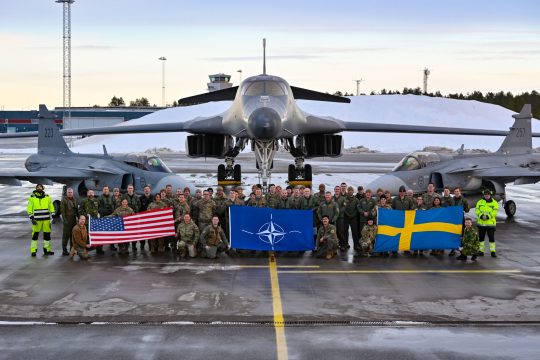
"This timely opportunity for our crews to exercise our collective defense capabilities with our Swedish partners, who will soon be NATO allies, in the Arctic region is incredible," said Lieutenant-colonel Benjamin Jamison, director of operations of the 37º Bomber Squadron and leader of the BTF 24-2. "This demonstrates our firm commitment to our partners and Allies, demonstrates our expansive reach and sends a strong message of deterrence to potential opponents."
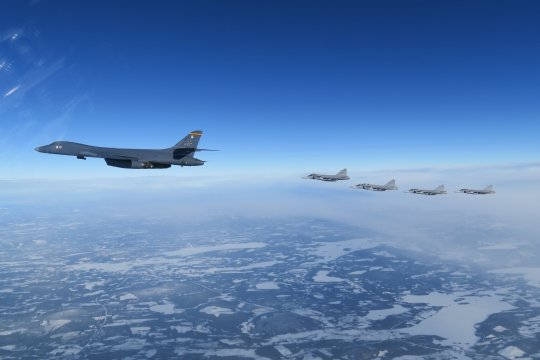
The ability to generate surges from locations like Lulea is a key focus area for the U.S. Air Forces in Europe - African Air Forces. Through Vanguard Adler, BTF 24-2 sought to exercise the ability to quickly integrate forces and equipment into allied and partner locations.
All training objectives have been achieved, according to the employees.

The US routinely demonstrates its commitment to the Allies and NATO partners through BTF missions. Through these missions, USAFE-AFAFRICA allows the dynamic use of forces in the European theater, providing strategic predictability and guarantee to the Allies and partners, while contributing to deterrence, introducing greater operational unpredictability for potential opponents.
Regular and routine deployments of U.S. strategic bombers also provide critical contact points to train and operate alongside our Allies and partners, while reinforcing a collective response to any global conflict.

BTF 24-2 marks the first multi-day deployment of U.S. Air Force B-1B bombers in Sweden.
Tags: Military AviationB-1B LancerBTFFlygvapnet - Swedish Air ForceJAS39 GripenUSAF - United States Air Force / U.S. Air Force
Sharing
tweet
Fernando Valduga
Fernando Valduga
Aviation photographer and pilot since 1992, he has participated in several events and air operations, such as Cruzex, AirVenture, Dayton Airshow and FIDAE. He has works published in specialized aviation magazines in Brazil and abroad. He uses Canon equipment during his photographic work in the world of aviation.
Related news
MILITARY
NATO unit A330 MRTT tanker carries out the first REVO mission with Czech Gripens
29/02/2024 - 10:10
MILITARY
Singapore decides to acquire 8 F-35A stealth jets, expanding its JSF fleet to 20
29/02/2024 - 08:30
INCIDENTS
IMAGES: Historic planes are damaged by apparent tornado at the USAF National Museum
02/29/2024 - 07:53
BRAZILIAN AIR FORCE
Natal Air Base receives new flight simulator with FAB technology
28/02/2024 - 19:16
MILITARY
PC-21 fleet reaches 500,000 hours of safe flight
28/02/2024 - 17:00
HELICOPTERS
Thales will provide Reality H flight simulators to train German army H145M pilots
28/02/2024 - 16:00
10 notes
·
View notes
Text
[“We struggled to explore why we aren’t supposed to talk about sex in academia. We agreed that the glossed-over, vague clinical teachings about the importance of emotional intimacy, and the insistent linking of all healthy sexual expression with emotional intimacy, is a part of the same shaming of sexual desire and agency that leads clients—especially women and queer clients—to our offices.
Ultimately the dean supported my curriculum and my explicit conversations about sex and sex practices in my classroom, but with one caveat: text and some photography only. No pornography in the classroom.
Most of the text I teach to my students isn’t writing that’s coming out of the field of clinical psychology. It’s from queer theorists, sex educators, self-identified sex radicals, AIDS activists, and sex workers who are interrogating issues of cultural (mis)appropriations and shame. So even without showing pornography in my classroom, there was always enough sexually explicit material to talk about. Or so I thought.
Students started reporting in class about their experiences in their clinical internships. As when I was an intern, many training clinics, where the majority of supervisory staff or clinicians are heterosexual, have a tendency to assign all of the queer clients to the queer clinicians, regardless of gender expression or sex practices. The result looks something like this: dyke interns unfamiliar with gay male sexual expressions find themselves as new therapists sitting with gay male clients struggling with questions of safer sex and HIV risk. White gay men who don’t know about the spectrum of possible trans bodies find themselves needing to talk about hormones and packing cocks with African-American, genderqueer FTMs.
It isn’t that I expect my students to become experts in all forms of sexual and gender expression, but I do hope for them—and expect of them—that they become familiar enough, educated enough, and nonreactive enough to treat clients with respect and curiosity about their experiences and how they understand them, instead of needing their clients to educate them.
I assure my students that we all have ideas about sexualities and sexual practices that we have aversions to, don’t know anything about, or are simply not interested in, but that when we think about our clinical work, our own interest isn’t the point. I then tell them to go rent pornography and watch as many videos as it takes to learn five new things, and then do it again. Not necessarily sex acts or positions—though certainly those are learned—but more complicated representations and enactments of desire and power. This isn’t an exercise in converting them to any particular kind of sex practice; it is however, about broadening their ideas about sex practices and desires so that when clients come in who are often socialized to feel shame about their desires, their therapists won’t further shame them. We need to learn to be present with our clients’ experiences and desires, and to be curious about them without leading to the activation of our own fears or uncertainties.”]
keiko lane, from Imag(in)ing Possibilities: The Psychotherapeutic Potential of Queer Pornography, from the feminist porn book: the politics of producing pleasure, edited by tristan taormino, constance henley, and celine perreñas shimizu, 2013
251 notes
·
View notes
Text
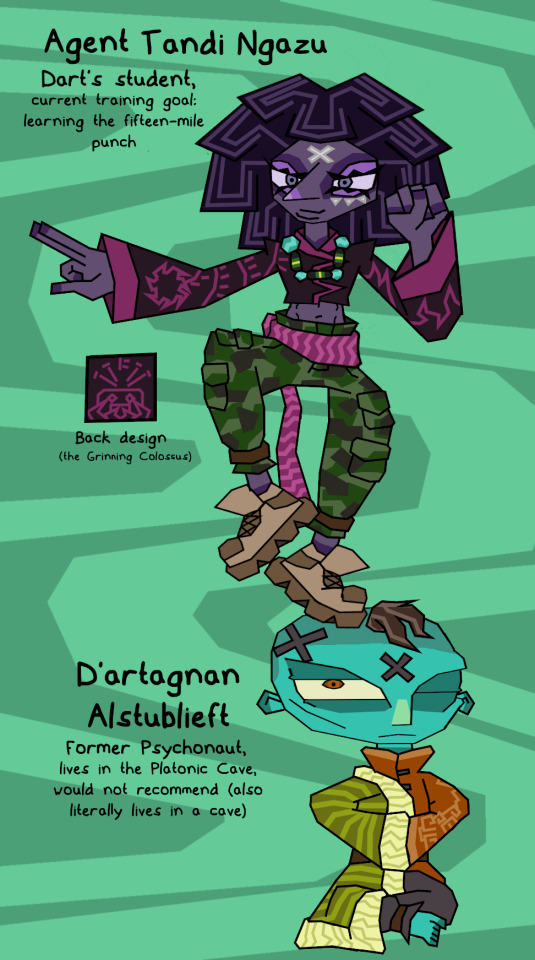
Some more OC beeswax I've had on the mind for a while, or half-OC in Dart's case. I know it's common to depict him either the same age as Raz or younger, sometimes making him the next-generation Intern to Adult Raz, but then I thought 'what if he was older?' And then I threw in an unrelated OC and things mentally blew up. :V (This also plays off my earlier headcanons about Dart's power set)
Razputin wasn't the first psychic to be inducted into the Psychonauts at such a young age - Dart beat him to the punch by nearly twenty years. An orphan permitted to become a full-fledged agent on Otto's personal recommendation, he simply wasn't ready and got overconfident during a mission, indirectly causing the execution of several hostages. Horrified, he deserted the agency, dropping off the grid, only resurfacing years later after studying under a sect of psychic monks in the Himalayas that sent him out on his own to meditate and strengthen his connection with the collective unsconscious.
His journey took him to the obscure Central African country of Makanisi (nestled somewhere between Angola, Zambia and the DR Congo), known for two things: once being privately-owned by a Grulovian businessman, and being the site of the world's largest Psitanium deposit outside North America. He took up residence in a cave, banking on the Psitanium enhancing his astral projection powers.
It was here he met Tandi Ngazu, a psychic teenager from the Makanisian capital of Zoltzberg. A martial arts prodigy, Tandi ran away from home after she lost a championship bout and lashed out with her psychic powers, injuring her competitor in front of a huge audience. Dart found her hiding out in the slums while on a rare excursion into town, and reminded of how he was found by Otto as a street urchin in Rotterdam, he agreed to shelter the girl and give her some advanced tutoring - though due to his own relative youth and the fact he was on his own quest for understanding, he was far from confident. He was always a cynical person, and struggled with the whole 'empathy' thing, which in a way made him uniquely suited for 'taming' the collective unconscious without allowing it to affect his own emotional state.
Eventually, after about five years, a civil war broke out in Makanisi. Against Dart's advice, Tandi emerged from her secluded training to aid the rebels - many of whom she personally knew - in their struggle against the corrupt colonial government. She used Dart's training in astral projection to leave her own body while wide awake and completely ignore pain, gather information from people's mindscapes, and channel background psychic residue into physical attacks while far outside her body. She avoided the same fate that befell Lucrecia by staying guarded against outside influence and maintaining her sense of self even when among the Collective Unconscious, a technique mastered by Dart and soon noticed by the Psychonauts who arrived in the country to secure the Psitanium. She ended up joining the agency after Makanisi secured its freedom, but was unable to convince Dart to return with her.
That was all another five years before canon - Tandi is now 26 and has recently graduated to a full-fledged agent, and there's talk of letting her instruct the kids at Whispering Rock in combining out-of-body projection with physical exercise, provided they can work on her patience. Dart is 32 and his whereabouts are currently unknown, though rumour has it he's been sighted around the Questionable Area?, poking around through caves.
#psychonauts#psychonauts 2#psychonauts ocs#Stalkeyes Art#stalkeyes rambles#I tried my best to keep the backstory concise#believe me I could have made it five times as long#will gladly accept questions about em#d'artagnan#d'artagnan alstublieft#tandi ngazu#aged-up characters#Makanisi was first mentioned in my fic Intern-al affairs which I still need to add to at some point
31 notes
·
View notes
Text
Type 3
As requested by @sleepyowlwrites, here's a little prequel to this story:
There are three permanent types of diabetes, he remembered from his training. The first you're born with, and have to manage using insulin. The second you pick up during your life, and can sometimes manage with changes to diet and exercise, or other medication. The third you contract upon your death. There's nothing you can do about that.
Dr Theodore 'Ted' Spong was a good-humoured man. As parish physician, he had to be. People only came to him with complaints, and he couldn't very well meet them with his own; if he had any grumbles or gripes, he'd long since learnt to tuck them away, like the good brandy he kept in a cabinet back home. He largely worked in the public eye, but some things were best mulled over in his own time.
He hadn't grown up in the sticks, but he liked it here. Outside of surgery hours, he enjoyed long walks across the moors, taking in the beauty of the mist-soaked landscape; within them, he met a range of fascinating characters, the sort of people you never got to meet in the city, each with their own idiosyncrasies and health complaints. He'd come across conditions he'd only read about, and patients who'd never learnt to read.
The people here led simple lives, divorced from the innovation and progress that drowned the city in smoke, but that meant his job had been anything but. They could be credulous at times, and a large part of his time was spent championing science over superstition, miracle cures and folk remedies. Unfortunately, they now had a champion as well.
There was a new doctor in town, by the name of Madame Silja, and she was undoing all of his hard work. To call her a doctor was a courtesy, for she had clearly never studied for a licence as he had, or read any book of medicine less than a century old. She was driving his parish backwards, towards the dark ages of draining bad humours away, although he never saw her wading for leeches on his walks. In fact, he'd barely seen her at all, until the night she showed up at his surgery door.
"I feel unwell," Silja said. She looked it, too. Her face was gaunt and drained, her body likewise emaciated underneath her clothes, visible even in the gloom. This was a woman at death's door as much as his.
Ted fought the temptation to gloat. Oh, and the leeches didn't hit the spot? Come crawling for some proper medicine, have we? That wouldn't be right. Nemesis or not, this woman lived in the parish, and that made her his patient. He was a good natured man, and a physician first of all. If he was to bring her out into the light, the best way would be to lead by example.
"What are your symptoms?" he asked, ushering her inside. She stood uncertain in the doorway, perhaps also having second thoughts about coming to him for help, but there was no time to lose. "Please, come in."
"I feel... tired," she told him, collapsing on a proffered armchair. The cushion barely sank under her weight.
"You're losing weight?"
Silja nodded. "I'm losing my appetite. But in its place there's this incessant thirst, a void no amount of water seems to sate."
"Any changes to your mood? Feeling suddenly irritable?
"What do you think?" she snapped. "I've just told you I'm thirsty all the time. Yes, it's irritating. Have you ever had an itch that you can't scratch?"
Ted usually told his patients not to scratch any itch, but he kept quiet and let her settle down. Madame Silja seemed so frail, but there was still something threatening about her - something unsettling and strange. It was a tingle at the back of his neck, like something primal, but he forced it down again. He wouldn't scratch that itch either.
He had no room for prejudice in his work, nor outside of it, and that was probably all this was. He didn't often see people with her kind of ancestry, not since he'd left the city. Whatever ancestry that was. Her skin was dark, although it seemed that it had since grown paler. She reminded him of a colleague from his studies, an Ottoman doctor by the name of Şefik. Was her name similar? Perhaps he could try to build a bridge between them.
"Tell me - you wouldn't happen to have any Turkish blood in you, by any chance?"
"Oh, I dare say I might," Silja replied. The question had served its purpose, for she flashed a smile for the first time, but Ted found himself more unsettled than ever. "Why do you ask? Is it something to do with my illness?"
"No, no, I was just curious," he said, increasingly nervous. "I know it isn't my place to guess, but I thought I'd take a stab in the dark."
"I'm not a fan of those, as a rule," she said. "But thank you for taking an interest. My patients are... rarely conversational. I don't often get to talk about myself. Do you find the same? Do you live nearby?"
"The good news is that I think I recognise your symptoms." Ted moved back onto steadier ground. "Although I'll need to take a blood sample."
"Oh, of course."
"For testing," he clarified. Anxiety or not, he wouldn't tolerate any of that nonsense here, in his temple of modern medicine. "Then we'll move on to treatment."
It was diabetes, he was sure, but he didn't know which strand. Was this a late diagnosis of type one? She didn't look much like a typical case for type two. There were others, he knew: gestational diabetes, picked up in pregnancy to meet the additional demands on the body. Perhaps it was something like that. A change, as if the whole body was gestating, metamorphosing into something... no, there was no medical basis for that. What was he saying?
"You might need to start taking medicine," he told her. "But mostly I suspect you'll need to make some changes to your diet."
"That's fine by me," she said, flashing another awful smile. "I'd figured that part out myself."
7 notes
·
View notes
Video
4th Tank Battalion trains with Moroccan counterparts during African Lion 2011 [Image 1 of 8] An M1A1 Abrams Main Battle Tank from Company E, 4th Tank Battalion, 4th Marine Division, fires a round down range from its 120mm main gun during a training mission here May 22 as part of African Lion 2011. African Lion is an annually scheduled, bilateral exercise between the Kingdom of Morocco and the U.S. that involves more than 2,000 U.S. service members and approximately 900 members of the Royal Moroccan Armed Forces. African Lion Photo by Tech. Sgt. Sean Worrell Date Taken:05.22.2011 Location:CAP DRAA, MA Related Photos: dvidshub.net/r/372cjo
(via 4th Tank Battalion trains with Moroccan counterparts durin… | Flickr)
15 notes
·
View notes
Text
youtube
#youtube#militarytraining#Senegal Military#Counterterrorism Training#War Games#Close Quarter Battle Training#Special Forces Training#Security Forces#Military Training#Army Training#Special Operations#Close Quarters Combat#Training Exercises#Military Exercises#Senegal Army#Military Operations#Flintlock 24#Tactical Training#Military Drills#Senegal Special Forces#African Special Forces#Combat Training
1 note
·
View note
Photo

Dr. Philip Emeagwali is the Inventor of the World's Fastest Computer.
Popularly called the "Bill Gates of Africa", the Famous African Inventor from Onitsha, Anambra State, was born in Akure, Ondo State.
Like many African schoolchildren, he dropped out of school at age 14 because his father could no longer afford to train him in school.
Even after dropping out of school, his father didn't give up on his son. He continued teaching him at home. It was recorded that everyday, his father made Emeagwali performed mental exercises such as solving 100 math problems in one hour.
Fifteen months after Emeagwali's high school education began, the Nigerian Civil War broke out. Him and his family fled to the eastern part of the country and he was surprisingly drafted into the Biafran Army.

Emeagwali's family lived in a refugee camp until the war ended in 1970. More than half a million Biafrans died of starvation.
He didn't give up on his dreams, he studied hard and got scholarship to Oregon State University when he was 17 where he obtained a BS in mathematics. He also earned three other degrees – a Ph.D. in Scientific computing from the University of Michigan and two Masters degrees from George Washington University.
In his words, "My focus is not on solving nature's deeper mysteries. It is on using nature's deeper mysteries to solve important societal problems."

36 notes
·
View notes
Text

At its height in the 1840s, the West African kingdom of Dahomey boasted an army so fierce that its enemies spoke of its “prodigious bravery.” This strong force, known as the Agojie, raided villages under cover of darkness, took captives and slashed off resisters’ heads to return to their king as trophies of war. Through these actions, the Agojie established Dahomey’s preeminence over neighboring kingdoms and became known by European visitors as “Amazons” due to their similarities to the warrior women of Greek myth. They were also called Mino, or Minon, "our mothers".
During their membership, they were not allowed to have children or be part of married life (though they were legally married to the king). Many of them were virgins.
The Mino trained with intense physical exercise. They learned survival skills and indifference to pain and death, storming acacia-thorn defenses in military exercises and executing prisoners. Discipline was emphasized. Serving in the Mino offered women the opportunity to "rise to positions of command and influence" in an environment structured for individual empowerment. The Mino were also wealthy and held high status.
The women's army consisted of many regiments: huntresses, riflewomen, reapers, archers, and gunners. Each regiment had different uniforms, weapons, and commanders. In a later period, the Dahomean female warriors were armed with Winchester rifles, clubs, and knives. Units were under female command.
In 1890 King Béhanzin started fighting French forces during the First Franco-Dahomean War. European observers noted that the women "handled admirably" in hand-to-hand combat. The Amazons participated in one major battle: Cotonou, where thousands of Dahomey (including many Amazons) charged the French lines and engaged the defenders in hand-to-hand combat. Despite the compliments given to them by the Europeans, the Amazons were decisively crushed, with several hundred Dahomey troops being gunned down.
By the end of the Second Franco-Dahomean War, special units of the Amazons were being assigned specifically to target French officers. After several battles, the French prevailed and ended the independent Dahomean kingdom. French soldiers, particularly of the French Foreign Legion, were impressed by the boldness of the Amazons and later wrote about their "incredible courage and audacity" in combat.
The troops were disbanded when the kingdom became a French protectorate. Oral tradition states that some surviving amazons secretly remained in Abomey afterward, where they quietly assassinated some French officers. Other stories say the women pledged their services to protect Agoli-Agbo, the brother of Béhanzin, disguising themselves as his wives to guard him. Some of the women married and had children, while others remained single.
The last survivor of the Dahomey Amazons is thought to have been a woman named Nawi. In a 1978 interview in the village of Kinta, a Beninese historian met Nawi, who claimed to have fought the French in 1892. Nawi died in November 1979, aged well over 100.
•••
Estando en su mejor momento en los 1840, el reino Dahomey ubicado en África occidental, presumía de un ejército tan feroz que hasta sus enemigos hablaban acerca de su “prodigiosa valentía”. Estas fuerzas poderosas eran conocidas como las Agojie, atacaban pueblos mientras que iban cubiertas por la oscuridad de la noche, tomaban cautivos y cortaban cabezas para llevárselas como trofeo de guerra a su rey. A través de estas acciones, las Agojie establecieron preeminencia sobre los reinos vecinos y fueron conocidas por los visitantes europeos como "Las Amazonas" debido a sus similitudes con las mujeres guerreras del mito griego. También fueron llamadas Mino, o Minon, "nuestras madres".
Mientras que fueran miembros de las fuerzas, no se les permitía tener hijos o ser parte de la vida matrimonial (aunque estaban legalmente casadas con el rey). Muchos de ellas eran vírgenes.
Las Mino se entraban con ejercicios físicos intensos. Aprendieron habilidades de supervivencia e indiferencia al dolor y la muerte, asaltaban defensas en ejercicios militares y ejecutaban prisioneros. Se enfocaron en la disciplina. Servir como Minons, le ofreció a las mujeres la oportunidad de "ascender a puestos de mando e influencia" en un entorno estructurado para el empoderamiento individual. Las Mino también eran ricas y tenían un alto estatus.
Este ejército de mujeres consistían de varios regimientos: cazadoras, fusileras, segadoras, arqueras y artilleras. Cada regimiento tenía diferentes uniformes, armas y comandantes. En un período posterior, las guerreras de Dahomey estuvieron armadas con rifles Winchester, garrotes y cuchillos. Las unidades estaban bajo mando femenino.
En el año 1890, el rey Béhanzin comenzó a luchar contra las fuerzas francesas durante la Primera Guerra Franco-Dahomeana. Los observadores europeos notaron que las mujeres "se manejaron admirablemente" en el combate mano a mano. Las amazonas participaron en una gran batalla: Cotonou, donde miles de Dahomey (incluidas muchas de las amazonas) atacaron las líneas francesas y se enfrentaron a los defensores en un combate mano a mano. A pesar de los cumplidos que les dieron los europeos, las amazonas fueron aplastadas de manera decisiva, y cientos de soldados Dahomey fueron asesinados a tiros.
Al final de la Segunda Guerra Franco-Dahomeana, se asignaron unidades especiales de las Amazonas específicamente para atacar a los oficiales franceses. Después de varias batallas, los franceses prevalecieron y terminaron con el reino independiente de Dahomey. Los soldados franceses, específicamente los de la Legión Extranjera Francesa, quedaron impresionados por la audacia de las amazonas y luego escribieron acerca del "increíble coraje y audacia" que mostraron en combate.
Las tropas se disolvieron cuando el reino se convirtió en un protectorado francés. La tradición oral dice que algunas amazonas sobrevivientes permanecieron en secreto en Abomey, donde asesinaron en silencio a algunos oficiales franceses. Otras historias dicen que las mujeres prometieron servir y proteger a Agoli-Agbo, el hermano de Béhanzin, muchas disfrazándose como esposas para protegerlo. Algunas de las mujeres se casaron y tuvieron hijos, mientras que otras permanecieron solteras.
Se cree que la última sobreviviente de las amazonas de Dahomey fue una mujer llamada Nawi. En una entrevista de 1978 en el pueblo de Kinta, un historiador beninés conoció a Nawi, quien afirmó haber luchado contra los franceses en 1892. Nawi murió en noviembre de 1979, con más de 100 años.
Source | Fuente: African American Registry
Spanish translation by Long Live Blackness
Traducción al español por Long Live Blackness
#blacklivesmatter#blacklivesalwaysmatter#english#spanish#blackhistory#history#share#read#blackpeoplematter#blackhistorymonth#blackgirlsrock#black queen#blackhistoryyear#blackwomenmatter#black warriors#warriors#black lives matter#blm#newpost#historyfacts#african history#blackbloggers#lupita nyong'o#knowyourhistory#knowledgeisfree#knowledgeispower#did you know#dahomey#2022#kingdom
27 notes
·
View notes
Text
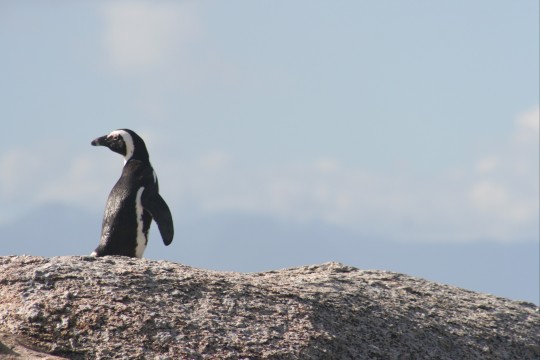

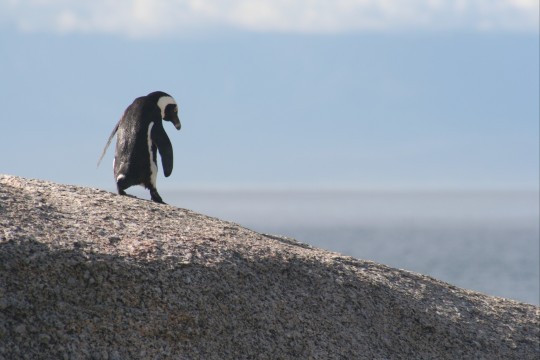

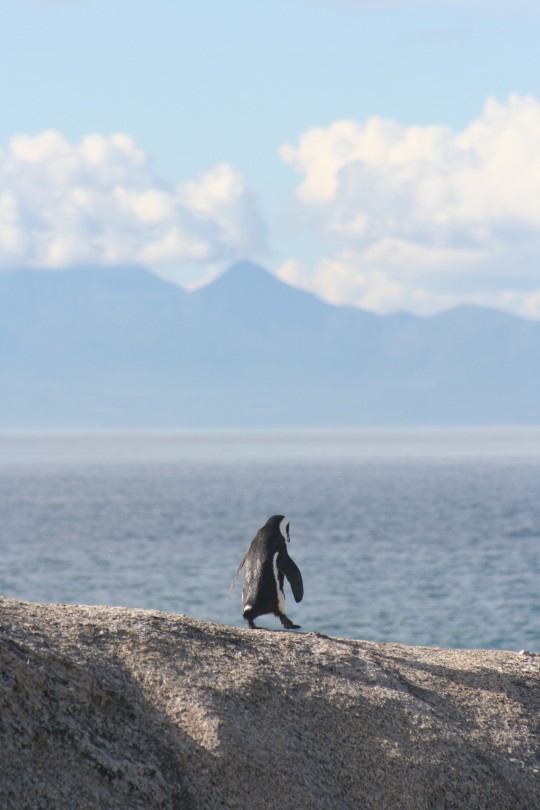

African penguin, endemic to the southern coast of South Africa, with colonies at Algoa Bay, Betty's Bay, offshore islands, and the famous Boulders Beach. They are endangered after a population collapse due to overfishing, years of egg harvesting, and annihilation of their habitat on the shore. Their future is grim, with indifferent regard by the government beyond tourism revenue. On Feb 1 2024 after extensive protests against blasting in a protected habitat the South African Navy set off underwater explosives in a 'training' exercise next to Boulders Beach powerful enough to shake houses inland. Recent measures like no-fishing zones in small areas adjacent to the colonies may be too little, too late. Some experts estimate extinction to occur within ten years.
https://www.news24.com/fin24/climate_future/news/watch-underwater-explosives-go-off-in-simons-town-near-endangered-african-penguin-colony-20240201
#south africa#africa#original photography on tumblr#wildlife photography#african birds#african penguin#penguin#western cape
4 notes
·
View notes
Text
Authorizes an increase of $198.5 million for partner capacity building through the
International Security Cooperation Programs account within the Defense Security
Cooperation Agency and intends for this additional funding to be allocated as follows:
$20 million for SOUTHCOM; $20 million for AFRICOM; $5 million for NORTHCOM; and
$100 million for EUCOM.
Authorizes $50 million for AFRICOM’s intelligence, surveillance, and reconnaissance
(ISR) and associated production, exploitation, and dissemination support.
Requires an independent assessment of DOD efforts to train, advise, assist, and equip
the military forces of Somalia.
Authorizes an increase of $10 million to support AFRICOM efforts to assess
opportunities to diversify the locations of its multilateral military exercises on the
African continent.
Authorizes $165.3 million for the continued training and equipping of vetted Syrian
groups and individuals and extends the waiver for the caps on the costs of construction
and repair on a per-project basis, related to temporary and humane detention for one
year.
Extends the authority to provide assistance to Iraq to counter the Islamic State of Iraq
and Syria (ISIS), extends a waiver for the caps on the costs of construction and repair
on a per-project basis, related to temporary and humane detention for one additional
year.
7 notes
·
View notes
Text
Introduction
In August 1619, enslaved Africans touched foot in the first permanent English settlement in what is now the United States. The centuries since witnessed the development of a racial system more violent, extractive, and deeply entrenched than any other in human history. Yet where there is oppression, there is resistance. Since 1619, Black radicals and revolutionaries have taken bold collective action in pursuit of their freedom, threatening the fragile foundations of exploitation upon which the United States is built. These heroic struggles have won tremendous victories, but they have also produced martyrs—heroes who have been imprisoned and killed because of their efforts to transform society.
“Black August” is honored every year to commemorate the fallen freedom fighters of the Black Liberation Movement, to call for the release of political prisoners in the United States, to condemn the oppressive conditions of U.S. prisons, and to emphasize the continued importance of the Black Liberation struggle. Observers of Black August commit to higher levels of discipline throughout the month. This can include fasting from food and drink, frequent physical exercise and political study, and engagement in political struggle. In short, the principles of Black August are: “study, fast, train, fight.”
George Jackson and the origins of Black August
George Jackson was a Field Marshal of the Black Panther Party while he was incarcerated in San Quentin Prison in California. Jackson was an influential revolutionary and his assassination at the hands of a San Quentin prison guard was one of the primary catalysts for the inception of Black August.
A 19-year-old convicted of armed robbery, in 1961 George Jackson was sentenced to a prison term of “1-to-life,” meaning prison administrators had complete and arbitrary control over the length of his sentence. He never lived outside of a prison again, spending the next 11 years locked up (seven and a half years of those in solitary confinement). In those 11 years—despite living in an environment of extreme racism, repression, and state control—George Jackson’s political fire was ignited, and he became an inspiration to the other revolutionaries of his generation.
Jackson was first exposed to radical politics by fellow inmate W.L. Nolen. With Nolen’s guidance, Jackson studied the works of many revolutionaries, including Karl Marx, V.I. Lenin, Mao Tse-Tung, and Frantz Fanon. Nolen, Jackson, and other prisoners dedicated themselves to raising political consciousness among the prisoners and to organizing their peers in the California prison system. They led study sessions on radical philosophy and convened groups like the Third World Coalition and started the San Quentin Prison chapter of the Black Panther Party. Jackson even published two widely read books while incarcerated: Soledad Brother and Blood in My Eye.
Unfortunately, if predictably, these radical organizers soon found themselves in the cross-hairs of the California prison establishment. In 1970, W.L. Nolen—who had been transferred to Soledad prison and planned to file a lawsuit against its superintendent—was assassinated by a prison guard. Days later, George Jackson (also now in Soledad Prison) and fellow radical prisoners Fleeta Drumgo and John Clutchette were accused of killing a different prison guard in retaliation for Nolen’s death. The three were put on trial and became known as the Soledad Brothers.
That year, when it was clear that George Jackson would likely never be released from prison, his 17-year-old brother Jonathan Jackson staged an armed attack on the Marin County Courthouse to demand the Soledad Brothers’ immediate release. Jonathan Jackson enlisted the help of three additional prisoners—James McClain, William Christmas, and Ruchell Magee—during the offensive. Jonathan Jackson, McClain, and Christmas were all killed, while Magee was shot and re-arrested. Ruchell Magee, now 80 years old, is currently one of the longest held political prisoners in the world.
On August 21, 1971, just over a year after the courthouse incident, a prison guard assassinated George Jackson. The facts regarding his death are disputed. Prison authorities alleged that Jackson smuggled a gun into the prison and was killed while attempting to escape. On the other hand, literary giant James Baldwin wrote, “no Black person will ever believe that George Jackson died the way they tell us he did.”
While the particular circumstances of Jackson’s death will likely forever remain contested, two facts are clear: his death was ultimately a political assassination, and his revolutionary imprint can’t be extinguished. Through the efforts and sacrifice of George and Jonathan Jackson, Nolen, McClain, Christmas, Magee and countless other revolutionaries, the 1970s became a decade of widespread organizing and political struggle within prisons. Prisoners demanded an end to racist and violent treatment at the hands of prison guards, better living conditions, and increased access to education and adequate medical care. Tactics in these campaigns included lawsuits, strikes, and mass rebellions. The most notable example may be the Attica Prison rebellion, which occurred in New York State just weeks after George Jackson was murdered. In protest of the dehumanizing conditions they were subjected to, about 1,500 Attica Prison inmates released a manifesto with their demands and seized control of the prison for four days, beginning on September 9, 1971. Under orders from Governor Nelson Rockefeller, law enforcement authorities stormed Attica on September 12 and killed at least 29 incarcerated individuals. None of the prisoners had guns.
This is the context out of which Black August was born in 1979. It was first celebrated in California’s San Quentin prison, where George Jackson, W.L. Nolen, James McClain, Willam Christmas and Ruchell Magee were all once held. The first Black August commemorated the previous decade of courageous prison struggle, as well as the centuries of Black resistance that preceded and accompanied it.
Political prisoners and the prison struggle
Observers of Black August call for the immediate release of all political prisoners in the United States. That the US government even holds political prisoners is a fact they attempt to obscure and deny. In reality, dozens of radicals from organizations such as the Black Panther Party, the Black Liberation Army, the American Indian Movement, and MOVE have been imprisoned for decades as a result of their political activity. As Angela Davis, who was at one time the most high profile political prisoner in the US, explains:
“There is a distinct and qualitative difference between one breaking a law for one’s own individual self-interest and violating it in the interests of a class of people whose oppression is expressed either directly or indirectly through that particular law. The former might be called criminal (though in many instances he is a victim), but the latter, as a reformist or revolutionary, is interested in universal social change. Captured, he or she is a political prisoner… In this country, however, where the special category of political prisoners is not officially acknowledged, the political prisoner inevitably stands trial for a specific criminal offense, not for a political act… In all instances, however, the political prisoner has violated the unwritten law which prohibits disturbances and upheavals in the status quo of exploitation and racism.”
Prisons in the United States are a form of social control which serve to maintain the status quo of oppression. Over the last few decades, prisons have become an increasingly important tool for the US ruling class. Prisons not only quarantine revolutionaries, but also those segments of the population who have become increasingly expendable to the capitalist system as globalized production, deindustrialization, and technological automation decrease the overall need for labor-power. These shifts, which began in earnest in the 1970s, have hit Black, Latino, and Indigenous communities the hardest, as exemplified by the sky high unemployment and incarceration rates those communities face. These groups are also historically the most prone to rebellion. Angela Davis noted in 1971 that as a result of these trends, “prisoners—especially Blacks, Chicanos and Puerto Ricans—are increasingly advancing the proposition that they are political prisoners. They contend that they are political prisoners in the sense that they are largely the victims of an oppressive politico-economic order.”
Though that definition of political prisoner is unorthodox, it illustrates the political and economic nature of criminalization. This is why observers of Black August connect the fight to free “revolutionary” political prisoners to the broader struggle against US prisons. Mass incarceration is a symptom of the same system that political prisoners have dedicated their lives towards fighting.
As increasing numbers of the US working class are “lumpenized,” or pushed out of the formal economy and stable employment, the potential significance of political struggle among the unemployed and incarcerated increases. George Jackson wrote in Blood in My Eye that “prisoners must be reached and made to understand that they are victims of social injustice. This is my task working from within. The sheer numbers of the prisoner class and the terms of their existence make them a mighty reservoir of revolutionary potential.”
George Jackson’s own journey is a perfect example of that revolutionary potential. Jackson didn’t arrive in prison a ready-made revolutionary. He had a history of petty crime and was apolitical during his first years in prison. He would have been dismissed by many people in our society as a “thug.” But comrades who knew that he held the potential inherent in every human being found him and took him in. They helped him understand his personal experiences within the context of capitalism and white supremacy. In turn, George Jackson dedicated his life to doing the same for others incarcerated individuals.
Black August today
August, more than any other month, has historically carried the weight of the Black Liberation struggle. Of course, enslaved Africans were first brought to British North America in August 1619. Just over 200 years later, in August 1831, Nat Turner led the most well-known rebellion of enslaved people in US history. This historical significance carried into the 20th century, when both the March on Washington for Jobs and Freedom and the Watts Rebellion—an explosive uprising against racist policing in Los Angeles—occurred in August during the 1960s.
Even today, the month remains significant in the struggle. John Crawford, Michael Brown, and Korryn Gaines were three Black Americans who were murdered in high-profile cases of police brutality; Crawford and Brown in August 2014, and Gaines in August 2016. Their deaths have been part of the impetus for a revived national movement against racist police brutality. Finally, on August 21, 2018, the 47 year anniversary of George Jackson’s death, thousands of U.S. prisoners launched a national prison strike. They engaged in work stoppages, hunger strikes, and other forms of protests. The strike lasted until September 9, 47 years after the Attica Prison Uprising began. Like the Attica prisoners, the 2018 prison strike organizers put forth a comprehensive list of demands that exposed the oppression inherent to the U.S. prison system, and laid out a framework to improve their conditions.
Each of these historical and contemporary events reveal a truth that the Black radical tradition has always recognized: there can be no freedom for the masses of Black people within the white supremacist capitalist system. The fight for liberation is just that: a fight. Since its inception in San Quentin, Black August has been an indispensable part of that fight.
In the current political moment, when some misleaders would have us bury the radical nature of Black resistance and instead prop up reformist politics that glorify celebrity, wealth, and assimilation into the capitalist system, Black August is as important as ever. It connects Black people to our history and serves as a reminder that our liberation doesn’t lie in the hands of Black billionaires, Black police officers, or Black Democratic Party officials. Those “Black faces in high places” simply place a friendly face on the system that oppresses the masses of Black people in the United States and around the world, often distorting symbols of Black resistance along the way. Black liberation lies, as it always has, in the hands of the conscious and organized masses. Study, train, fight, and in the words of George Jackson, “discover your humanity and your love of revolution.”
4 notes
·
View notes